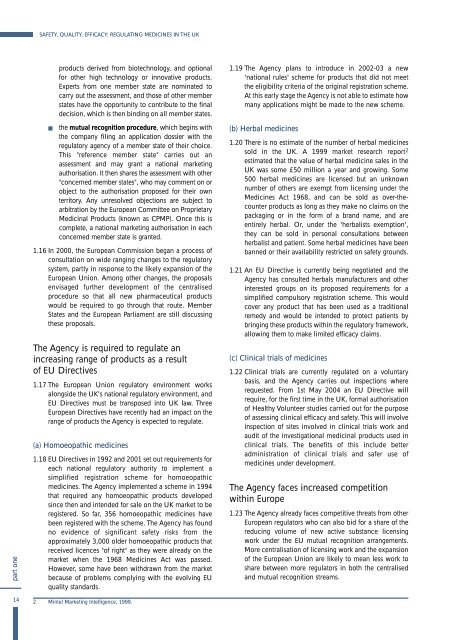Safety, Quality, Efficacy: Regulating Medicines in the UK
Safety, Quality, Efficacy: Regulating Medicines in the UK
Safety, Quality, Efficacy: Regulating Medicines in the UK
- No tags were found...
You also want an ePaper? Increase the reach of your titles
YUMPU automatically turns print PDFs into web optimized ePapers that Google loves.
SAFETY, QUALITY, EFFICACY: REGULATING MEDICINES IN THE <strong>UK</strong><br />
products derived from biotechnology, and optional<br />
for o<strong>the</strong>r high technology or <strong>in</strong>novative products.<br />
Experts from one member state are nom<strong>in</strong>ated to<br />
carry out <strong>the</strong> assessment, and those of o<strong>the</strong>r member<br />
states have <strong>the</strong> opportunity to contribute to <strong>the</strong> f<strong>in</strong>al<br />
decision, which is <strong>the</strong>n b<strong>in</strong>d<strong>in</strong>g on all member states.<br />
1.19 The Agency plans to <strong>in</strong>troduce <strong>in</strong> 2002-03 a new<br />
'national rules' scheme for products that did not meet<br />
<strong>the</strong> eligibility criteria of <strong>the</strong> orig<strong>in</strong>al registration scheme.<br />
At this early stage <strong>the</strong> Agency is not able to estimate how<br />
many applications might be made to <strong>the</strong> new scheme.<br />
part one<br />
! <strong>the</strong> mutual recognition procedure, which beg<strong>in</strong>s with<br />
<strong>the</strong> company fil<strong>in</strong>g an application dossier with <strong>the</strong><br />
regulatory agency of a member state of <strong>the</strong>ir choice.<br />
This "reference member state" carries out an<br />
assessment and may grant a national market<strong>in</strong>g<br />
authorisation. It <strong>the</strong>n shares <strong>the</strong> assessment with o<strong>the</strong>r<br />
"concerned member states", who may comment on or<br />
object to <strong>the</strong> authorisation proposed for <strong>the</strong>ir own<br />
territory. Any unresolved objections are subject to<br />
arbitration by <strong>the</strong> European Committee on Proprietary<br />
Medic<strong>in</strong>al Products (known as CPMP). Once this is<br />
complete, a national market<strong>in</strong>g authorisation <strong>in</strong> each<br />
concerned member state is granted.<br />
1.16 In 2000, <strong>the</strong> European Commission began a process of<br />
consultation on wide rang<strong>in</strong>g changes to <strong>the</strong> regulatory<br />
system, partly <strong>in</strong> response to <strong>the</strong> likely expansion of <strong>the</strong><br />
European Union. Among o<strong>the</strong>r changes, <strong>the</strong> proposals<br />
envisaged fur<strong>the</strong>r development of <strong>the</strong> centralised<br />
procedure so that all new pharmaceutical products<br />
would be required to go through that route. Member<br />
States and <strong>the</strong> European Parliament are still discuss<strong>in</strong>g<br />
<strong>the</strong>se proposals.<br />
The Agency is required to regulate an<br />
<strong>in</strong>creas<strong>in</strong>g range of products as a result<br />
of EU Directives<br />
1.17 The European Union regulatory environment works<br />
alongside <strong>the</strong> <strong>UK</strong>'s national regulatory environment, and<br />
EU Directives must be transposed <strong>in</strong>to <strong>UK</strong> law. Three<br />
European Directives have recently had an impact on <strong>the</strong><br />
range of products <strong>the</strong> Agency is expected to regulate.<br />
(a) Homoeopathic medic<strong>in</strong>es<br />
1.18 EU Directives <strong>in</strong> 1992 and 2001 set out requirements for<br />
each national regulatory authority to implement a<br />
simplified registration scheme for homoeopathic<br />
medic<strong>in</strong>es. The Agency implemented a scheme <strong>in</strong> 1994<br />
that required any homoeopathic products developed<br />
s<strong>in</strong>ce <strong>the</strong>n and <strong>in</strong>tended for sale on <strong>the</strong> <strong>UK</strong> market to be<br />
registered. So far, 356 homoeopathic medic<strong>in</strong>es have<br />
been registered with <strong>the</strong> scheme. The Agency has found<br />
no evidence of significant safety risks from <strong>the</strong><br />
approximately 3,000 older homoeopathic products that<br />
received licences "of right" as <strong>the</strong>y were already on <strong>the</strong><br />
market when <strong>the</strong> 1968 <strong>Medic<strong>in</strong>es</strong> Act was passed.<br />
However, some have been withdrawn from <strong>the</strong> market<br />
because of problems comply<strong>in</strong>g with <strong>the</strong> evolv<strong>in</strong>g EU<br />
quality standards.<br />
(b) Herbal medic<strong>in</strong>es<br />
1.20 There is no estimate of <strong>the</strong> number of herbal medic<strong>in</strong>es<br />
sold <strong>in</strong> <strong>the</strong> <strong>UK</strong>. A 1999 market research report 2<br />
estimated that <strong>the</strong> value of herbal medic<strong>in</strong>e sales <strong>in</strong> <strong>the</strong><br />
<strong>UK</strong> was some £50 million a year and grow<strong>in</strong>g. Some<br />
500 herbal medic<strong>in</strong>es are licensed but an unknown<br />
number of o<strong>the</strong>rs are exempt from licens<strong>in</strong>g under <strong>the</strong><br />
<strong>Medic<strong>in</strong>es</strong> Act 1968, and can be sold as over-<strong>the</strong>counter<br />
products as long as <strong>the</strong>y make no claims on <strong>the</strong><br />
packag<strong>in</strong>g or <strong>in</strong> <strong>the</strong> form of a brand name, and are<br />
entirely herbal. Or, under <strong>the</strong> 'herbalists exemption',<br />
<strong>the</strong>y can be sold <strong>in</strong> personal consultations between<br />
herbalist and patient. Some herbal medic<strong>in</strong>es have been<br />
banned or <strong>the</strong>ir availability restricted on safety grounds.<br />
1.21 An EU Directive is currently be<strong>in</strong>g negotiated and <strong>the</strong><br />
Agency has consulted herbals manufacturers and o<strong>the</strong>r<br />
<strong>in</strong>terested groups on its proposed requirements for a<br />
simplified compulsory registration scheme. This would<br />
cover any product that has been used as a traditional<br />
remedy and would be <strong>in</strong>tended to protect patients by<br />
br<strong>in</strong>g<strong>in</strong>g <strong>the</strong>se products with<strong>in</strong> <strong>the</strong> regulatory framework,<br />
allow<strong>in</strong>g <strong>the</strong>m to make limited efficacy claims.<br />
(c) Cl<strong>in</strong>ical trials of medic<strong>in</strong>es<br />
1.22 Cl<strong>in</strong>ical trials are currently regulated on a voluntary<br />
basis, and <strong>the</strong> Agency carries out <strong>in</strong>spections where<br />
requested. From 1st May 2004 an EU Directive will<br />
require, for <strong>the</strong> first time <strong>in</strong> <strong>the</strong> <strong>UK</strong>, formal authorisation<br />
of Healthy Volunteer studies carried out for <strong>the</strong> purpose<br />
of assess<strong>in</strong>g cl<strong>in</strong>ical efficacy and safety. This will <strong>in</strong>volve<br />
<strong>in</strong>spection of sites <strong>in</strong>volved <strong>in</strong> cl<strong>in</strong>ical trials work and<br />
audit of <strong>the</strong> <strong>in</strong>vestigational medic<strong>in</strong>al products used <strong>in</strong><br />
cl<strong>in</strong>ical trials. The benefits of this <strong>in</strong>clude better<br />
adm<strong>in</strong>istration of cl<strong>in</strong>ical trials and safer use of<br />
medic<strong>in</strong>es under development.<br />
The Agency faces <strong>in</strong>creased competition<br />
with<strong>in</strong> Europe<br />
1.23 The Agency already faces competitive threats from o<strong>the</strong>r<br />
European regulators who can also bid for a share of <strong>the</strong><br />
reduc<strong>in</strong>g volume of new active substance licens<strong>in</strong>g<br />
work under <strong>the</strong> EU mutual recognition arrangements.<br />
More centralisation of licens<strong>in</strong>g work and <strong>the</strong> expansion<br />
of <strong>the</strong> European Union are likely to mean less work to<br />
share between more regulators <strong>in</strong> both <strong>the</strong> centralised<br />
and mutual recognition streams.<br />
14<br />
2 M<strong>in</strong>tel Market<strong>in</strong>g Intelligence, 1999.

















